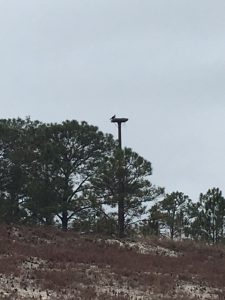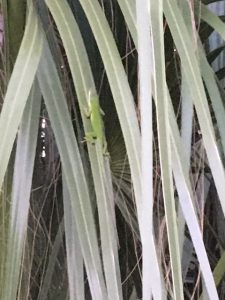One of the things that has caught my attention since we began observing wildlife in our yards is the large number of squirrels – there are a lot of them here. We already discussed their territorial combats, but it drew my focus to their nests. It is spring… there are a lot of nests – and this is the primary reason the territorial combats are occurring with many of the creatures in our neighborhood.

Photo: Rick O’Connor
Spring is famous as being the time of year for new birth. Animals of all kinds are laying eggs and raising their young. It is true that not all animals nest during the spring, many prefer the fall, or even the winter. This makes sense in that there would not be enough food and space if everyone had their babies at the same time. And not everyone builds nests. Birds are famous for them – and we should find some today. But some creatures find places to they their eggs or have their pups. For this article we will say “if they build it – it is a nest”, “if they find it – it is a den”.
Many creatures build nests – again, we are very familiar with birds. Many species work very hard over long periods of time to build these. Eagles and ospreys build huge ones (maybe there is one in your neighborhood). These are made from specially selected sticks and then lined internally with soft straw and feathers. The Great Horned Owl likes to use either osprey or eagle nests when not in use. There is one on the public trail at Shoreline Line Park South in Gulf Breeze. Not sure the babies are still there, but if you live in the area, this would be cool to see. More on this in the ACTIVITY,
Closer to home we have a boxwood bush in the front yard that a mockingbird has used for years. It is very difficult to see the nest – it is tucked up in their – but you can see the parents leave and return with food for the chicks every day. They are also very aggressive to anything coming to close. I saw them attack a squirrel who was trying to get to one of our bird feeders the other day. They also get upset when crows or hawks get nearby – understandably. Interesting, they do not get upset at a pair of wrens who are also nesting in the boxwood. This has not happened before, it is usually just the mockingbird, but this year they are sharing the space peacefully.
Around the corner there is another pair of wrens using the attic vent of our house. They do so every year. You can hear the small chicks in their now calling for food and witness the mom (or dad) flying out on multiple trips to find food for them.

In the old oak tree we have been observing these past three weeks, there are numerous holes chiseled out by red-bellied woodpeckers. There are at least two pairs there, maybe more, and I have noticed they get very upset when redheaded woodpeckers show up. All these years watching them, I have not seen a redheaded woodpecker drill a cavity for eggs. They have tried, but they have lost.
And of course, there are several squirrel nests in the water oaks. Their nests are built of straw and leaves. I have not paid attention to the number there are in each tree – but a good activity for today – because there squirrels everywhere. They are fighting a lot, but they seem to allow more than one nest in each tree, we will see how many we find per tree today.

I am not sure where the green and Cuban anoles lay their eggs. Many reptiles lay their nests underground – sea turtles are famous for this. Six inches down it remains a constant temperature and the eggs can be warm and safe – if no other animal finds them. Unlike birds and squirrels, reptiles usually do not sit by their nests and guard them. Since they do not protect them, they will lay many eggs. Sea turtles can lay around 100! You will not see mockingbirds or wrens doing this. An interesting thing about most turtle eggs – the temperature of the egg will determine whether it is a male or female. The eggs closer to the surface, where it is warmer, will become female.
One exception to that rule are the alligators. They will build their nests above ground out of leave litter in large mounds. The eggs are inside, and the temperature still determines male and female, but the parents do stay close by and will guard them. If the babies begin to make a squawking sound – she will come – so be aware!

Photo: Rick O’Connor
But as for our Anole lizards – I have not found them. Literature indicates they usually do not build nests but rather scrap the sand and leave one egg in the space. Should be a fun activity to do today – let’s see if we can find one!
Mammals usually do not build nests, but rather find dens (the squirrels being an exception). Raccoons, opossums, and even fox and coyote live our neighborhoods. Some of them den in the spring but others will den during the winter and the young are now actively seeking food. Mammal dens are difficult to find as well – and should be. They move mostly at night and we rarely see them other than their tracks. For some of us, armadillos maybe in an empty lot nearby. They usually make a small round hole in the ground. For those in south Santa Rosa County, black bears are becoming more common. But I would not look for these!
Because of the COVID-19 situation, we should stick pretty close to home while searching for nests today. You may live near a park or trail, and it is fine to explore those, but aware of social distance and be safe.
Let’s find some nests!
ACTIVITY
1. We can begin with counting how many squirrel nests there are in each tree in your yard. I bet you will see the squirrels quarreling over food.
2. Next, see if you can find bird nests. Again, remember, the parents do not want you around their eggs or babies, so keep a safe distance – for both you and the babies.
3. If you have green (or Cuban) anoles – can you find any eggs? It will be hard. I have not – but will be looking today. I know where they like to hang out and I am going to carefully explore the ground in that area. Pulling back some grass or pine straw and see what I can find.
4. Woodpeckers – do you have these? They like old trees (which a lot of people cut down now) but if you can find one maybe the woodpeckers are there. What kind of woodpecker is living there? How many?
5. If you live in Gulf Breeze, and you are safe, you might venture out to see the Great Horned Owl nest. Go to Shoreline Park South – park across the street from the dog park – walk south (towards) the water until you find the concrete path that leads into the woods – maybe 100 yards or so down you will see a large nest on your right high up in a dead tree. There were 3 baby owls in it. Not sure if they are there now.
6. You may have osprey nesting nearby. How many do you have? Are they nesting in live or dead trees?
7. Lastly, maybe you will find something totally new. That would be cool also.
HAVE FUN AND STAY SAFE.
 0
0
